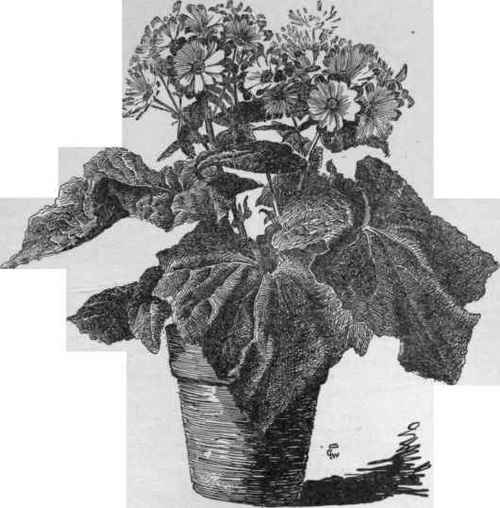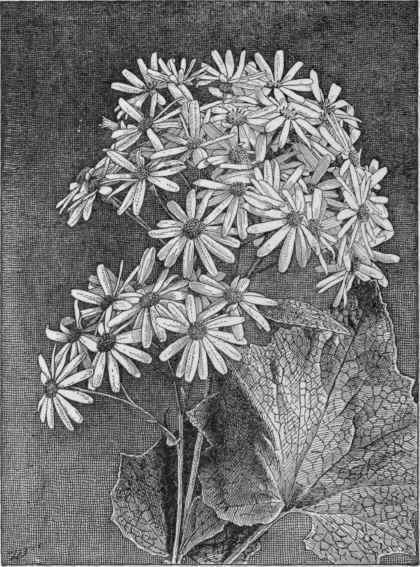Cineraria
Description
This section is from the book "The Standard Cyclopedia Of Horticulture Vol2", by L. H. Bailey. See also: Western Garden Book: More than 8,000 Plants - The Right Plants for Your Climate - Tips from Western Garden Experts.
Cineraria
(ash-colored, from the Latin, referring to the gray foliage). Compositae. Herbs or under-shrubs, closely allied to Senecio, from which they are separated chiefly by technical characters of the achene. The genus is variously understood by different authors. As limited by Bentham & Hooker, and also by Engler & Prantl, it comprises about 25 South African species, and the common garden Cineraria becomes a Senecio (S. cruentus, DC.)- The genus Cineraria differs from Senecio in having a conelike rather than branched style, and a usually flattened or many-angled rather than terete achene; the species are herbs or sub-shrubs with yellow flower-heads.
The cine-raria of the florists (Fig. 964) is now much modified by cultivation. There are two views of its origin, one holding that it is a direct development of C. cruenta, Mass. (Pericallis cru-enta, Webb. & Berth.), B.M. 406; the other that it is a hybrid, into which C. cruenta, C. Heritieri, C. populifolia, and perhaps others, have probably blended. These are all natives of the Canary Islands. For important literature respecting the origin of the garden cineraria, see Nature, 51:461, 605; 52:3, 29, 54, 78, 103, 128; 55:341. G.C. III. 3:654, 657; 17:588, 655, 742; 18: 89, 186; 29:297.

Fig. 964. Small plant of the florists' cineraria. - Botanically Senecio cruentus.
The florists' cinerarias run in white, and in shades of blue, pink and purple-red. There is promise of yellow-flowered strains by hybridizing with yellow senecios or related plants.
See Senecio for Cineraria acanthifolia, C. candidis-sima, and C. maritima. To the garden or florists' cineraria (C. cruenta) belong the horticultural names C. grandiflora, C. kewensis, C. nana, C. stellata, and others. There are full-double forms (see R.H. 1874, p. 47; 1886, p. 41. F.S. 22:2347-8. I.H. 32:556.)-C. flavescens, Hort., is a garden hybrid between Cineraria "Feltham Beauty" and Senecio auriculatissimus. G.C. III. 45, 322. Gn. 73:252. It is a compact grower, originating with James Veitch & Sons, giving promise of a new strain of winter-blooming plants: flowers creamy yellow, the younger blooms almost canary yellow; If. peculiarly constricted at the middle and much enlarged at the top. - C. hybrida, Hort., is a hybrid between Senecio cruentus and S. tussilaginis, with white flowers having pale blue tips on the rays and purplish centers. G.M. 55: 337. - C. stellata, Hort., now a popular race of florists' cineraria, has open spready panicles of star-like single flowers Fig. 965. Most excellent.
The true yellow-flowered South African cinerarias seem not to be in cultivation, although C. pentactina, Hook. f., has been recorded in horticultural literature within recent years: slender and climbing, with lax paniculate inflorescence, pale red flower-stems and five golden yellows rays in each head. B.M. 7799. Elegant greenhouse climber. l. H. B.
Culture of the florists' cineraria.
The single hybrid cinerarias are among the most useful and beautiful of all greenhouse flowering plants.
The ease with which they can be raised, the little heat required, together with their free-blooming qua1it ies, brilliant and various-colored flowers, which last for a considerable time in blossom, make them popular with most people possessing even only a small greenhouse. Though they are herbaceous in character and may be propagated by cuttings or division of the roots, the single varieties are best treated as annuals, raising them from seed each year and throwing away the plants after flowering. Although one may save one's own seed, the cinerarias, like most hybrids, will deteriorate both in size and quality of the flower after one or two generations unless they are crossed; therefore, unless one cares to cross one's own plants, it is best to purchase fresh seed from some reliable firm that secures its stock [from hybridists. For florists use, or when a succession of these flowers is required, two sowings of seed should be made-the first about the middle of August, and the second a month later. The seed should be sown in pans or shallow boxes 1 foot square; these should be well drained, and the soil should consist of one part fine loam, one part leaf-mold, and one part clean sharp silver sand. The surface should be made very fine and pressed down evenly.
The seed should then be sown evenly and rather thinly, and covered with sand about the eighth part of an inch. This will in a great measure prevent the seedlings from what gardeners term "damping off," which they are very apt to do if the atmospheric conditions become at all stagnant. The seed-pans or boxes should be carefully watered with a fine rose and then placed in some cool shaded place, such as a frame placed on sifted coal-ashes on the north side of a wall or building, where they will germinate in about a week or ten days. As soon as large enough to handle conveniently, the seedlings should be potted into thumb-pots and grown on as rapidly as possible, shifting on into larger size pots as often as required, never allowing them to become the least pot-bound, or suffer in any way during the season of growth. The soil should consist of half leaf-mold and half fine fibrous loam, with a good sprinkling of silver sand, until the final shift into their flowering pots, when the soil should be three parts fibrous loam and one part well - decayed cow-manure or pulverized sheep-manure. About the first of October the plants should all be removed to the greenhouse, where the atmosphere should be kept cool and moist, but not stagnant.
If a rainy spell should set in, a little artificial heat should be given to cause a circulation of the atmosphere, and as autumn advances the temperature should be kept about 45° at night, with a rise of 10° by day. Liquid stimulants should not be given until the flower-buds begin to appear, when they are greatly benefited by an occasional watering of clear liquid cow- or sheep-manure. The plants should be well in bloom after the holidays.
If bloom is wanted in late fall or early winter, seed may be sown in May; keep the plants growing all summer, but do not let them bloom till they are established in 5- or 6-inch pots.
The Star cineraria (Fig. 965), now popular, is an open grower, 2 feet, not having the large solid masses of flower-heads of the older larger-flowered kinds. The blooms are single and mostly smaller, and the rays are separated as in a wild aster. These plants go under the name of C. stellata. They are very free flowering, and as pot plants are more decorative than the large-flowered types; they meet the present demand for simplicity. In color they have the same range as the ordinary florists' cinerarias; and there are cactus-flowered strains, with narrow rolled petals. The star cinerarias require the same handling and treatment as the others.

Fig. 965. Stellata, a popular form of cineraria. (X1/2)
Double-flowered varieties of cineraria are not commonly grown, neither are they so beautiful as the single varieties. They may be propagated by seed or by cuttings, the latter being the best method, as a large percentage of seedlings are sure to turn out single, which will be inferior in size of flower as compared with the best single varieties. Double-flowering varieties must be propagated each year to secure the best results. As soon as the plants have finished blossoming, the flower stalks should be cut away to induce the plants to make fresh growth, which, as soon as large enough for cuttings, should be taken off and inserted in an ordinary propagating bed, where they will soon root, after which they should be potted and shifted on as often as required, growing them during the hottest months in as cool and shaded a position as can be provided.
Cinerarias are very subject to the attacks of greenfly. To keep these in check, the house in which they are grown should be fumigated with tobacco about once in ten days, or tobacco stems placed among the plants if fumigating is objectionable; or the cyanide treatment used. See Diseases and Insects.
Of the different species of Cineraria from southern Europe (properly Senecios), C. maritima is perhaps the best. It is of dwarf habit, with tomentose, silvery, pinnatifid leaves, and is a most useful subject for edging flower-beds. It is not hardy in the North, consequently must be treated as an annual, sowing the seeds early in March in the greenhouse, afterward treating it as an ordinary summer bedding plant. The other species from south and eastern Europe do not prove hardy North, and if grown should be treated as tender annuals, planting them in the herbaceous borders for the summer. The species from the Cape of Good Hope require greenhouse treatment, the culture being the same as for the common cineraria, although, from an ornamental point of view, most of them would hardly pay for the room they would occupy. Edward J. Canning.
Continue to:


